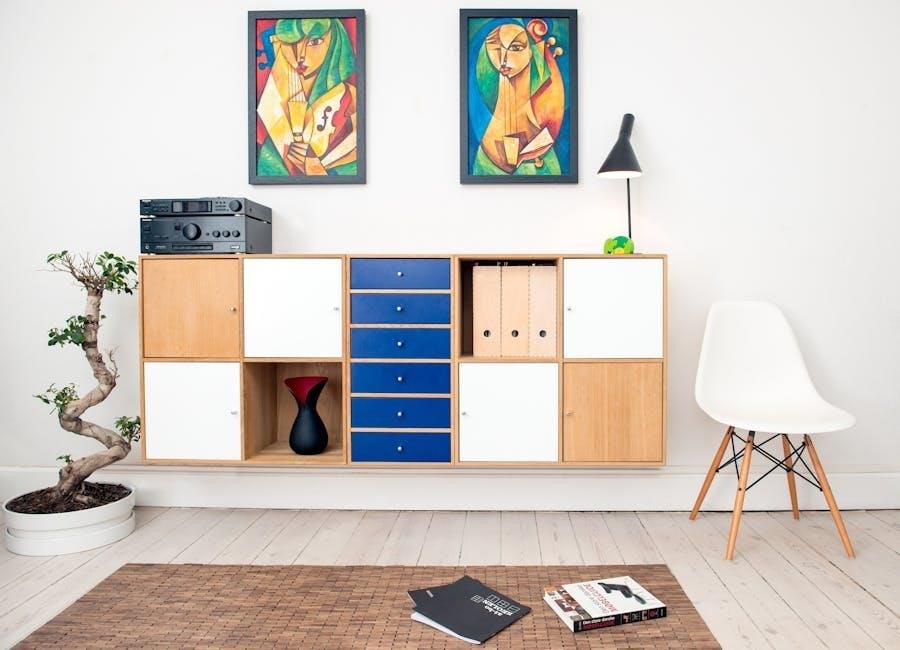Proper cabinet pull placement enhances functionality and aesthetics, ensuring ease of use while maintaining a clean, balanced look. While no strict rules exist, guidelines like using jigs for consistent spacing and considering drawer size help achieve optimal results. Pulls reduce hand contact, keeping cabinets cleaner, and their strategic placement avoids clutter. This guide offers tips for aligning pulls, mixing styles, and ensuring proportion, helping you make informed decisions for a polished finish;
Understanding the Importance of Proper Placement
Proper cabinet pull placement is crucial for both functionality and aesthetics. It ensures handles are easy to grip, reducing strain and preventing damage. Incorrect placement can make hardware look cluttered or misaligned, detracting from the overall design. Size and style consistency are key to maintaining a balanced look. Pulls also reduce hand contact with cabinets, keeping them cleaner. Strategic placement allows for a cohesive design, whether mixing styles or maintaining uniformity. This attention to detail elevates the usability and visual appeal of your space, making it essential for a polished finish.
Overview of Cabinet Pull Styles and Sizes
Cabinet pulls come in various styles, from modern bar handles to traditional cup pulls, offering versatility for different designs. Sizes range to suit drawer and door dimensions, ensuring proportionality. Choosing the right size prevents handles from looking oversized or insignificant. For large drawers, multiple pulls or longer handles may be needed. Styles should align with the kitchen’s aesthetic, whether contemporary or rustic. Mixing styles is possible but requires balance to maintain a cohesive look. Properly selected pulls enhance functionality and contribute to the overall visual harmony of the space.

General Guidelines for Cabinet Pull Placement
Proper pull placement enhances functionality and aesthetics. Place pulls opposite hinges, use a jig for precise spacing, and align with drawer size. Vertical pulls ease grip, while horizontal ones offer a modern look. Ensure consistency across all cabinets for a balanced appearance.
Standard Placement Based on Hinge Location
Pull placement is often determined by the hinge location. For standard alignment, place pulls on the opposite side of the hinge. The bottom screw of the pull typically sits 2.5 to 3 inches from the bottom of the drawer or door. Use a jig to ensure consistent spacing and alignment. Vertical pulls on drawers enhance grip, while horizontal pulls on doors offer a modern aesthetic. Always center pulls on large drawers for a balanced look, ensuring functionality and visual harmony across your cabinetry.
Size and Proportion Considerations
Choosing the right pull size ensures both functionality and visual appeal. Smaller drawers or doors work best with knobs or compact pulls, while larger surfaces benefit from longer pulls. Divide the drawer front into thirds; place pulls in the first and third sections for balance. For large drawers, use multiple pulls spaced evenly; Proportion is key—select hardware that complements the cabinet’s height and depth. Mixing styles can add character, but ensure consistency across the space for a cohesive design. Always measure carefully to achieve a polished look.

Specific Placement Considerations
Align pulls vertically for larger drawers and horizontally for smaller ones. Center pulls on doors for symmetry, while false drawer fronts may or may not include pulls, depending on design preferences.
Drawer Pulls: Vertical vs. Horizontal Placement
Drawer pull placement depends on size and style. Vertical pulls are ideal for large drawers, offering better grip and ease of use. Horizontal pulls suit smaller drawers, blending seamlessly with modern designs. For consistency, align pulls with the drawer’s center or divide the front into thirds for proportional placement. Use a jig to ensure accurate hole spacing. Consider functionality and aesthetics when choosing orientation. Mixing styles can enhance visual appeal, but maintain uniformity across adjacent drawers for a cohesive look. Always test placement before drilling for optimal results.
Cabinet Door Pulls: Central or Off-Center Options
Cabinet door pulls can be placed centrally for a balanced, symmetrical appearance or off-center for a modern, asymmetrical look. Central placement is ideal for traditional designs, while off-center placement adds visual interest. Ensure pulls align with the hinge location for functionality. For larger doors, divide the height into thirds and place the pull in the upper or lower third. Use a jig for precise spacing. Off-center pulls work well on tall cabinets or pantry doors. Maintain consistency across adjacent doors for a cohesive look. Consider the door’s proportions and your kitchen’s style when deciding placement.
False Drawer Fronts: When and Where to Use Pulls
False drawer fronts often feature pulls for aesthetic consistency with real drawers. However, their use depends on functionality and design. Always include a pull on a false drawer front if it needs to be opened, such as for access to a sink or appliances; Avoid pulls on purely decorative fronts, especially near plumbing to prevent interference; Align the pull with adjacent drawers for a balanced look. Central placement is recommended for symmetry. Consider the door’s height and divide it into thirds for proportional placement. This ensures a cohesive and functional design.
Hardware Style and Finish Matching
Matching cabinet pulls with your kitchen’s aesthetic ensures a cohesive look. Choose styles and finishes that complement surrounding decor for aesthetic harmony and functionality. Mix styles thoughtfully to avoid clutter.
Matching Cabinet Pulls with Overall Kitchen Style
Choosing cabinet pulls that align with your kitchen’s style ensures a cohesive design. For traditional kitchens, opt for classic knobs or ornate pulls. Modern spaces benefit from sleek, minimalist designs like bar pulls or flat handles. Transitional kitchens can blend styles, combining subtle knobs with understated pulls. Consider the finish—brushed nickel, chrome, or bronze—to complement other fixtures. Mixing styles is possible but should be done thoughtfully to avoid visual clutter. The goal is to create a harmonious look that enhances both functionality and aesthetics seamlessly.
Mixing Hardware Styles: Tips and Tricks
Mixing cabinet hardware styles can add unique personality to your space, but it requires balance. Start with a dominant style, then incorporate complementary accents, like knobs on doors and pulls on drawers. Ensure a unifying element, such as finish or design era, ties the look together. Proportion is key—larger hardware suits hefty cabinets, while smaller pieces work for delicate doors. For visual cohesion, align hardware placement consistently across all cabinets. Finally, consider the kitchen’s overall aesthetic to guide your mixing decisions and achieve a harmonious, intentional design.
Tools and Materials Needed
A jig ensures consistent hole spacing, while a drill, screwdriver, measuring tape, and level are essential for precise installation. Marking screw holes accurately prevents mistakes.
Essential Tools for Accurate Placement
A jig is crucial for consistent hole spacing, ensuring alignment and symmetry. A drill with precise bits, a screwdriver, and a measuring tape are indispensable for accurate measurements. Use a level to ensure pulls are straight and evenly spaced. Marking screws with a pencil helps avoid drilling errors. A stud finder can locate structural supports, while clamps may assist in securing hardware. These tools collectively ensure professional-grade installation, preventing costly mistakes and enhancing the overall appearance of your cabinets.
Using a Jig for Consistent Hole Spacing
A jig is indispensable for achieving precise hole spacing when installing cabinet pulls. It ensures alignment with the hinge location, maintaining uniformity across all drawers and cabinets. By using a jig, you eliminate measurement errors and save time. It guides the drill bits accurately, preventing misaligned holes. This tool is especially useful for large projects, ensuring a professional finish. Proper jig usage guarantees consistent spacing, enhancing the overall aesthetic and functionality of your cabinetry hardware placement.

Advanced Placement Tips
Advanced techniques involve centering pulls on large drawers for symmetry and aligning pulls on adjacent cabinets for a cohesive look, ensuring consistency and visual harmony.
Centering Pulls on Large Drawers
Centering pulls on large drawers ensures a balanced and polished look. For drawers over 30 inches wide, place the pull in the center horizontally. Vertically, position it 1/3 from the top for better grip. Use a jig to mark precise holes, ensuring alignment. For extra-wide drawers, consider multiple pulls spaced evenly to distribute weight. This method enhances functionality and aesthetics, maintaining symmetry and ease of use. Proper centering avoids visual clutter and ensures drawers operate smoothly, making it a key detail in cabinet design. Always measure carefully for consistent results.
Aligning Pulls on Adjacent Cabinets
Aligning pulls on adjacent cabinets creates a cohesive and visually appealing design. Start by determining a consistent height for all pulls, typically 1/3 from the top of the drawer or door. Use a level tool to ensure straight alignment. Measure from the edge of the cabinet to maintain uniform spacing. For multiple rows, align pulls vertically to avoid a staggered look. This method ensures harmony and balance, making the space feel more organized and professionally designed. Proper alignment enhances functionality and aesthetic appeal, creating a polished finish. Always double-check measurements for accuracy.
Special Considerations
Special considerations involve placing pulls on pantry doors and tall cabinets, ensuring proper alignment and aesthetic consistency. Address varying cabinet heights and depths for functionality.
Placement on Pantry Doors and Tall Cabinets
For pantry doors and tall cabinets, vertical pull placement is often recommended to complement the height. On tall cabinets, consider centering pulls at eye level or dividing the door height into thirds for balanced aesthetics. Ensure pulls are proportional to the door size, with larger pulls suited for taller cabinets. This approach enhances accessibility and visual harmony, making the space more functional and stylish. Proper alignment is key to maintaining a cohesive look across all cabinetry.
Handling Different Cabinet Heights and Depths
For cabinets with varying heights and depths, pull placement should be proportional to the size of the door or drawer. On taller cabinets, consider centering pulls vertically or placing them in the upper third for easy access. For deeper cabinets, align pulls horizontally with the door edges to maintain balance. Use a jig to ensure consistent spacing, and adjust pull size according to cabinet dimensions. This approach ensures functionality and aesthetic harmony, even in spaces with diverse cabinet sizes and layouts.

Maintenance and Adjustments
Regularly tighten loose pulls to prevent wear and ensure smooth operation. Clean around pulls gently to avoid damaging finishes. Adjust pull alignment as needed for consistent functionality and appearance.
Tightening Loosen Pulls Over Time
Over time, cabinet pulls can loosen due to frequent use, requiring periodic tightening. Use an Allen wrench or screwdriver to secure the screws firmly. Regularly inspect pulls for signs of wear or wobbling. For pulls with visible screws, tighten them directly. Concealed screw models may need the handle removed to access the mounting hardware. Ensure screws are snug but avoid overtightening, which could damage the cabinet front. Cleaning around pulls before tightening helps prevent dirt from affecting the screw hold. Addressing loose pulls promptly maintains functionality and aesthetics, preventing further damage or misalignment over time.
Cleaning Around Pulls Without Damaging Finish
Cleaning around cabinet pulls requires care to avoid damaging the finish. Use a soft, dry microfiber cloth to wipe away dust and grime. For tougher spots, dampen the cloth with warm water, but avoid harsh chemicals or abrasive cleaners. Gently scrub around the pulls, then dry thoroughly to prevent water spots. Regular cleaning prevents grime buildup and maintains the hardware’s appearance; For tight spaces, use a small, soft-bristled brush to remove debris without scratching the finish. This method ensures pulls remain clean and the surrounding area stays pristine.
Proper cabinet pull placement balances functionality and aesthetics, enhancing your kitchen’s usability and style. By following guidelines and tips, you can achieve a polished, cohesive look effortlessly.
Final Checklist for Perfect Pull Placement
- Measure drawer fronts in thirds for proportional placement.
- Align pulls opposite hinges for balanced functionality.
- Use a jig to ensure consistent hole spacing.
- Match hardware style and finish with your kitchen aesthetic.
- Check alignment with adjacent cabinets for a cohesive look.
- Inspect pulls for level and plumb placement.
- Tighten all screws firmly to prevent loosening over time.
- Step back and ensure a visually pleasing result.
